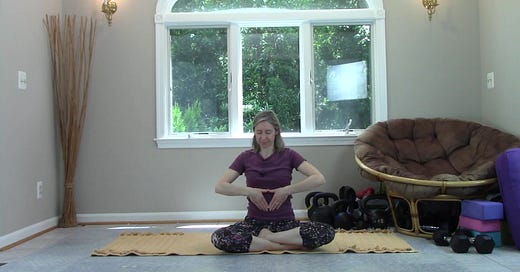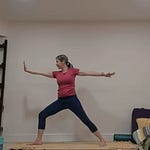Trigger warning: This post discusses the womb. If you have struggled with infertility, pregnancy loss, uterine, cervical, or ovarian cancers, or other issues related to the female sexual organs, or if you’ve had a hysterectomy, you may not feel up to reading this post today. With that said, the mudra and practice provided can be profoundly healing if you’re ready to dive in.
Don’t have time to read? Listen instead!
Dear yogini,
When was the last time you thought about your womb? Did you feel shame, discomfort, grief, anger, joy, numb?
I admit I never fully understood my female anatomy until recently. I do have a faint memory from health class freshman year of high school learning about the fallopian tubes and ovaries; there were pictures and words on a projector slide, but that’s all I internalized. I have no memory of connecting with these organs in my own body.
As I deepened my yoga studies and pursued anatomy education, I found female anatomy largely absent. I remember sitting in my living room poring over the words and photos describing how to perform Mula Bandha in Anatomy of Hatha Yoga, thoroughly confused. I unsuccessfully attempted to connect the words on the page to an experience in my body. "Maybe if I just keep trying, I’ll figure it out,” I thought.
It was a pelvic floor physical therapist and her biofeedback machine that finally helped me connect body and mind. I was afraid of tearing during my pregnancy with my son, so as a preventive measure I went to the PT. I’d heard rumors that yoga teachers often have a lot of pelvic floor issues around birth; while they are generally proficient at engaging their muscles due to bandha practice, they’re woefully bad at releasing them.1 I discovered I definitely did not figure out the whole bandha practice by continuing to “try.” I needed specific instruction and tangible feedback in order to get the hang of the whole pelvic floor.
Beyond the physical transformations and discoveries during pregnancy, I also experienced an unexpected energetic softening and sense of awe that my body could grow a human being. I could exist and another being could simultaneously exist inside me. It was alien-looking but also profound. Despite those frequent moments of awe, after delivering I went right back to not thinking about my uterus at all.
Looking back, I realize I’ve been attempting to access energetic experiences via physical practice for my entire adult life. While physical practices offer a good gateway to the subtle, traditional and hierarchical practices found in the ancient Hatha Yoga texts might not always be helpful when trying to access female power, seeing as most of these ancient practices weren’t designed for female bodies and experiences. It’s like using a spoon to cut an apple; it’s the wrong tool for the job.
Connecting to the energies of yonisthana chakra—fluidity, flow, grounded intuition, creativity, nurture, clarity—bring me back to that sense of softness and awe I experienced in pregnancy. I’ve found that the practices that most help me reconnect to these energies are not merely physical. Rather, mudras have helped me access womb energy. When I’m in contact with womb energy I feel powerful, strong, clear, and true but not in the dominating sense of those words. These energies, for me, feel collaborative, relational, imperfect, but right. The first time I practiced Yoni Mudra, I didn’t feel much. As I continued the practice, I’ve connected with a wellspring of swirling, loud, earnest energy eager to be freed through expression.
The power of the womb
We live in a society that does not appreciate the powers of the womb space, which is funny, because there’s an awful lot of people talking about the real consequences of the declining global birthrate. The womb possesses more than the generative power ensuring the survival of the human race, and women are more than their wombs. Appreciation of the real and raw power present in these energies are degraded in language and patriarchal societal norms. It is not considered polite or appropriate to use words like vagina, vulva, cunt, or yoni in casual conversation. The fact that the word cunt is considered one of the most vulgar of all vulgar words is a head-scratcher. Why is it so derogatory to be compared to the sexual organs that produce life on earth?
Uma Dinsmore-Tuli explains in Yoni Shakti:
“Language gives us power. To have no language to use about our bodies is to lose touch with ourselves. To be out of touch with ourselves is to be disempowered. For however passionately I may wish to convince you that the word ‘cunt’ is a fine term with an illustrious history and fascinating etymology, the fact that you have probably only ever heard it used as the nastiest kind of insult does make it hard to be enthusiastically cunt-positive. The fact that a term that so many people hold to be the most offensive word in the English language describes the most precious, beautiful, pleasure-and life-giving part of a woman’s anatomy tells us a lot about the esteem in which women’s bodies are held. And if our bodies are held in such contempt then there is not much hope for our spiritual empowerment.”
It’s always easier to connect with what can be seen and easily felt. Because women’s power is hidden (literally and figuratively, intentionally and unintentionally), Yoni Mudra, as a gesture of reverence and respect, can help you reconnect to a power that is innately yours.
Practicing Yoni Mudra
Practicing Yoni Mudra draws your conscious mind to the womb space and its associated powers. Though you can’t see them, and often don’t feel their presence, these powers reside within you always. Practicing Yoni Mudra provides certainty by connecting you directly to your intuitive wisdom. This type of clarity isn’t the type borne of book knowledge. This is felt-sense knowledge, that inner knowing that can’t always be described in words but is palpably understood in the body. For this reason, any surgery to remove the female sexual organs is significant not simply because it’s a large surgery from a medical perspective but also because it can feel like you’re losing a core part of who you are. Rest assured, the energy of yonisthana lives beyond the walls of the organs themselves, instead inhabiting a general space in the body between the first and second chakra. Simply placing your hands on the lower belly under the navel and above the vulva is a great place to start drawing your awareness toward this energy center.
Mudra means “seal”, “mark”, or “gesture” and is a way to amplify and direct energy in the body. The practice of Yoni Mudra is not about connecting to a particular organ, rather it is about connecting to what the space of the womb represents—your capacity to create, nurture, sustain, build, cycle, provide, nourish.
This mudra is safe to use in all seasons of your life as a way to connect to menstruation, fertility, or pregnancy, to help you heal postpartum, to keep you grounded and soft in the chaos that is early motherhood, and to bring you back to truth in the uncertainty of perimenopause/menopause/post-menopause. This practice can be done seated, lying down, standing or in yoga postures. It’s very versatile, generally easy, and relatively simple. No props or yoga experience required. I’ve shared a short demonstration and practice with several variations of Yoni Mudra below. I hope you enjoy this practice!
With gratitude,
Ashley
Connect with your creative intuition
To learn how to practice Yoni Mudra, please become a paid subscriber. Put into practice all the wisdom shared in the weekly newsletters and embody the wisdom of yoga today.













